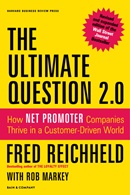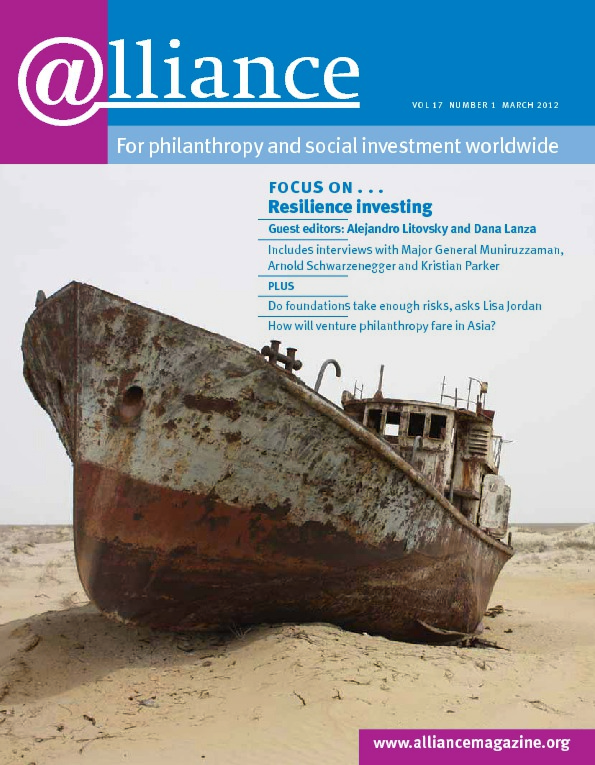 If you suspect that measurement and management are the weak links in philanthropy and development today, then you will probably want to read The Ultimate Question 2.0 as soon as possible. It is a clear, well-illustrated explanation of both the why and the how of ‘establishing accountability for the customer experience’. Reichheld and his colleagues have spawned a global movement of Net Promoter System (NPS) practitioners, and this book will plug you into the key concepts, tools and specialist community that you need to introduce effective NP practices in your organization. This is the definitive resource, full stop.
If you suspect that measurement and management are the weak links in philanthropy and development today, then you will probably want to read The Ultimate Question 2.0 as soon as possible. It is a clear, well-illustrated explanation of both the why and the how of ‘establishing accountability for the customer experience’. Reichheld and his colleagues have spawned a global movement of Net Promoter System (NPS) practitioners, and this book will plug you into the key concepts, tools and specialist community that you need to introduce effective NP practices in your organization. This is the definitive resource, full stop.
So what?
You care about this because NPS is a proven way to predict consumer corporate growth and profits, and organizations like Keystone Accountability believe that the customer satisfaction approach is even more relevant to development and social change than it is to business. This is so because those who are meant to enjoy the benefits of change are key to bringing it about. Customer satisfaction metrics allow you to see what those people really think.
We have known for 50 years that if you want smallholder farmers to adopt new practices – say, take up a hybrid seed or introduce a new cropping pattern – they are far more likely to do so if a farmer they respect is the one suggesting it. What we can now do, thanks to the insights of Reichheld and those who came before him in the customer satisfaction industry, is identify, recruit and support these farmer promoters.
I believe that in philanthropy and development, we stand where the business world stood in the early 1960s, when, despite initial scepticism from business heads, customer satisfaction emerged out of market research as a separate field. It is one of the profoundest ironies of philanthropy and development that business managers care more about customer satisfaction than philanthropists and development practitioners do about the views of intended beneficiaries. I define ‘care’ here as what one does rather than what one says, and for evidence I look for a rigorous practice of ‘accountability for customer experience’.
Let’s conclude with a quick look into the NPS toolkit.
Net Promoter Score
You get this by asking how likely it is that consumers would recommend Organization X to a friend or colleague (the ‘ultimate question’) on a scale of 0-10. Respondents are divided into Promoters (score 9-10; loyal enthusiasts who will keep buying and refer others, fuelling growth); Passives (score 7-8; satisfied but unenthusiastic; vulnerable to competitive offerings); Detractors (score 0-6; unhappy constituents who can damage your brand and impede growth through negative word of mouth). Your NP score is the percentage of customers who are Promoters minus the percentage who are Detractors. Once you know where your constituents sit on this scale you can take steps to increase Promoters and decrease Detractors.
Good and bad profits
For NPS, bad profits are those made from practices that boost short-term profits but antagonize customers – like mobile phone tariffs that trap you in for long periods. Good profits by contrast derive from such a good-quality experience that customers recognize the value in the relationship and become Promoters. I don’t care that my Apple MacBook Pro costs more than some other laptops. I know that it will have everything that I need, that the service quality on it is fantastic, and that it is aesthetically pleasing.
Net promoter economics
By analysing the costs, savings and profit margins associated with the different behaviours of Promoters, Passives and Detractors, it is possible to make the economic case for investing in NPS. It takes into consideration factors like retention rates, effects of word-of-mouth, cost efficiencies, customer spend and profit margins.
Each of these concepts has a direct analogy in development and social change programmes. Keystone has found that asking slightly different questions from the business sector’s ultimate question can uncover these analogues. It is still early days, and we find that different questions work well for different contexts. The key point, however, comes straight from the NPS playbook. The data collection process needs to be quick, easy and continuous.
NPS is a tool that puts those who are meant to benefit from philanthropy, development and social change at the heart of measurement and management practice. If this sounds like something you would like to see, you can’t get a better start than by reading this book.
David Bonbright is chief executive of Keystone Accountability. Email david@keystoneaccountability.org
To order
http://hbr.org
The Ultimate Question 2.0: How net promoter companies thrive in a customer-driven world
Fred Reichheld with Rob Markey Harvard Business Review Press £19.99/$27.95
ISBN 9781422173350





Comments (0)